Biomethanol is a kind of liquid biofuel. This is one of the monohydric alcohols. It is obtained through the processing of biological raw materials. Chemical component of it is the same as that of traditional methyl. Production technology it is not yet clearly established. This type of fuel can be obtained from any plant wastes (husk, dry leaves), animal waste products (manure, dung), and can efficiently recycle organic waste. Of biomass in the oxidation yield of biofuels is around 40 – 60%. One of the promising directions in the future for the extraction of this fuel is considered to be cultivation in special ponds, phytoplankton. Of phytoplankton receive biomethanol by biochemical conversion (fermentation of biomass and the further hydroxylation of methane). Production of biomethanol of phytoplankton has a number of advantages such as, the production of fuel is not used neither fresh water nor soil, phytoplankton has a high productivity (about 100 t/ha per year), good energy efficiency.
About 20% of the total consumption of bioethanol have to use in transport. The use of biomethanol in gasoline, is clearly governed by regulations on fuel quality. A valid part of biomethanol in gasoline should be equal parts of additives and amount to 3%.
Biomethanol widely used as a motor fuel. The warmth of its combustion is 40-50% lower than that of gasoline, but the production of heat during the application gaseous alcohol fuel mixture and gasoline are almost equal. Good for the filling of the cylinder, the evaporation of methanol at high temperature. Complete filling of the cylinder lowers the heat release rate, and, consequently, gaseous alcohol the mixture is completely combusted. Quality combustion of the mixture directly affects the power of the engine, complete combustion increases power output by 15%.
First biomethanol was obtained in 19th century wood. But the technology was inefficient, so is not widely spread, also still affected by the fact that this technology was immediately replaced by a gas conversion (natural).
As regular methanol, biomethanol used in traditional directions, and innovative. It is used in the chemical industry, in the manufacture of formaldehyde, high-octane additives, methylamines. It is used as industrial solvent. Also as a component it is added to the composition of antifreeze and natural gas, that would prevent the clogging in the pipeline.
But innovative use is that bioethanol is as an additive in gasoline, is widely used in fuel cells, as well as in the production of biodiesel to metilirovanie oil.
Biomethanol has both advantages and disadvantages of rad. Advantages are its very low CO2 emissions, the possibility of disposing of agricultural waste and livestock products. I especially want to highlight the disposal of organic waste, since this problem is particularly acute today. Well, the main raw materials for the production in abundance, and it is completely renewable. But the disadvantage is that due to the fact that methyl poisoning aluminum, problematic to use aluminum injection systems and carburetors. Also biomethanol draws water, and this negatively affects the fuel system, as it becomes clogged. The combustion of methanol occurs colorless flame, it can create an emergency situation.
Today worldwide there are 5 projects, they are implemented in Japan, Europe (Netherlands) and the United States.
Головна Biomethanol























